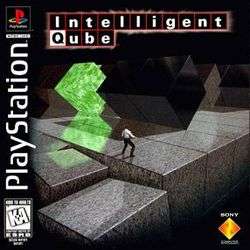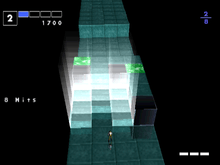I.Q.: Intelligent Qube
| I.Q.: Intelligent Qube | |
|---|---|
 | |
| Developer(s) | Epics (G-Artists) |
| Publisher(s) | Sony Computer Entertainment |
| Director(s) | Kenji Sawaguchi |
| Designer(s) | Masahiko Sato |
| Composer(s) | Takayuki Hattori |
| Platform(s) | PlayStation, PlayStation Network |
| Release date(s) |
PlayStation PlayStation Network |
| Genre(s) | Puzzle |
| Mode(s) | Single-player, multiplayer |
I.Q.: Intelligent Qube (Intelligent Qube in North America and Kurushi in Europe) is a puzzle game for the PlayStation. In the game, the player controls a character who must run around a platform made of cubes, clearing certain cubes as they approach. Cubes are "cleared" by marking a spot on the stage, waiting for the cube to roll on top of it, and then deactivating the marked spot.
The game was well received by critics. The game performed well commercially in Japan and even won the Excellence Award for Interactive Art at the 1997 Japan Media Arts Festival.[1] A few sequels have been developed and the game has since been re-released on PlayStation Network in Japan and Europe.
Game mechanics
Overview

At the beginning of each level the player is put on a stage that has 23-30 rows. Then 12-16 rows of the stage are raised. Anywhere between 1 and 4 sets of rows comes at the user at one time. On the first stage, 3 rows of length 4 (12 blocks) come at the user at one time. On the last stage, 14 rows of length 7 (98 blocks) come at the user at one time. When all the blocks in one set are destroyed, more blocks are raised—this happens 3 times, for a total of 4 block risings per level.
If the player ever falls off the stage- either by standing on the final row of the stage as it is eliminated, or by being "avalanched" off by rising blocks- the game is over.
Cube types
The cubes that approach are of three types:
- Normal cubes - Normal cubes are usually gray (the same color as the stage cubes you move around on), though this texture can change to some other color depending on the stage reached or on the game's settings . These cubes should be cleared.
- Advantage cubes - Advantage cubes are green and should be cleared. Clearing one of these cubes marks its location with a green square. This square can be subsequently triggered to clear the surrounding 3x3 area in one move. Multiple green cubes can be cleared normally, and puzzles usually incorporate advantage cube chains. If a spot is marked by a green square, it cannot be marked in the normal manner until the advantage cube's special feature is triggered. Effective use of advantage cubes is the key to solving puzzles efficiently. But at the same time, the player must make sure that no forbidden cube is included in the marked area (see below)
- Forbidden cubes - Forbidden cubes are black. These cubes should not be cleared, but should instead be allowed to fall off the stage. For every forbidden cube cleared, a row of the stage is lost, and a perfect score for that wave is no longer possible. In the first I.Q.: Intelligent Qube, if the player captures a Forbidden cube, red marks in the block scale will be cleared. Forbidden Cubes can be marked without being captured by an area surrounded by an Advantage Cube.
Additional penalties
If normal cubes or advantage cubes fall off the end of the stage without being cleared, the number of fallen cubes will be calculated on the block scale (i.e. a counter is increased by 1). Every time the number of fallen cubes exceed that of the block scale, a row of the stage is lost (thereby reducing the number of rows the cubes have to travel to fall off). This number is equal to the width of the stage minus one. On the first stage, the stage is 4 cubes wide, so the limit is 3; on the final stage, the limit is 6 because the stage is 7 cubes wide. If a normal or advantage cube falls off the end of the stage, that set is not considered perfect (see below).
If the player is flattened by the cubes rolling over him/her, the cubes will race to the end of the stage and fall off. All cubes (including forbidden cubes) will be counted on the block scale, and can make several rows of the stage fall away. The player will then have to face the same set of cubes again (except if the puzzle is the last set on the wave).
Bonuses
After each set of blocks is destroyed, if the player did so without destroying any forbidden cubes and cleared all normal and advantage cubes then they are awarded a bonus for perfection, and an additional row is added to the end of the stage (thereby increasing the number of rows the cubes have to travel to fall off the end of the stage). This is accompanied by a booming "Perfect!" from the game's announcer. Solving puzzles perfectly becomes increasingly important as the game progresses because later puzzles require more rolls, and hence more rows of running space, to complete successfully.
The perfection bonus takes into account how many cube rolls it took to clear all the cubes. From the time the first cube is cleared until the time the last cube is cleared, the counter increments. The immediate consequence of this is that one can mark a spot on the stage and wait to clear it until several rows of cubes roll over top of it. An initial number of rolls is set as being an ideal number to clear. If the player clears the cubes in exactly this number of rolls (Perfect in Kurushi Final), they are given a "Brilliant" bonus of 5,000 points. If the player clears the cubes in more than this number of rolls (Great in Kurushi Final), they are given a bonus of 1,000 points. If the player clears the cubes in fewer number of rolls (Excellent in Kurushi Final), they are given a "True Genius" bonus of 10,000 points.
Scoring
Clearing an individual cube is worth 100 points. Cubes cleared while an advantage cube is being detonated are worth 200 points each, regardless of if they are being cleared by the player or the advantage cube. At the end of each level, the number of the rows left on the stage is multiplied by 1,000 and added to the score—this score typically has a maximum of 40,000 (Except for the 1st, 3rd and Final Stages, their maximum scores are 27000, 39000 and 29000 respectively).
When the game is over, either by finishing all the levels or by falling off the stage, the total score is displayed, as well as an I.Q. This I.Q (a play on the term "intelligence quotient") is ostensibly the player's efficiency in clearing cubes, on a scale of 0 to 999 (for instance, beating the game without using a continue gives you an I.Q of at least 350); however, it is simply a percentage of the score.[2] Total scores for a well-played game without the use of continues are in the order of 1 million points. If the player falls of the stage, the player's progress of the game is displayed and at the same time will be asked if he or she will continue playing.
By beating the game multiple times, additional characters that move faster than the default character, are unlocked. Characters include Eliot (the default), Cynthia (Cherry in Kurushi), and Spike the dog. Each complete play through of the game takes approximately two hours at Level 0 speed, or about 75 minutes at Level 4 speed. Also, by beating the game once, players can unlock the Original Mode where a player can create their own puzzles. However, IQ and roll counters are not calculated.
Kurushi Final
In 1999, a sequel to I.Q.: Intelligent Qube was released known as Kurushi Final: Mental Blocks. The game play is similar to the first game, but there are several differences in terms of design, and new challenges are added such as 100 Attack, Survival Mode, and Create. In this game, the new default character is Abel. Unlike the first game, there are different unlockable characters in the game, including the original characters from I.Q.: Intelligent Qube. New unlockables include Kimti (a cave man), April (a nurse), Morgan (a military man), Dickson (a basketball player), and Atlas (a polar bear).
Kurushi Final
This is the normal game mode of the titular game. However, by beating the game with an IQ of 500 or above, the player unlocks Tektonics. If the player gets a game over, instead of asking to continue playing, the game allows the player to select a stage from the first up to the farthest stage where the player dies.
Tektonics
As mentioned above, the Tektonics is an extra mini-game unlocked after beating the game with an IQ above 500. This mode tests your skills in Kurushi. This is a game mode where the player must face a huge puzzle which lasts for only one set in 20 waves.
100 Attack
A game mode where a player faces 100 singular puzzles with the aim of clearing them within a set number of rotations.
Survival Mode
Similar to the normal game play. However, the game has no end. The player must survive as long as he can to unlock several characters.
Create
Similar to the Original Mode of the original IQ (see above) the only difference is that the total number of rotations are calculated.
Development
I.Q.: Intelligent Qube was designed by Masahiko Sato, a professor at the Tokyo University of the Arts.[3] Reviewers often remark on Takayuki Hattori's soundtrack, which opts for an eerie orchestral score rather than a typical 'bouncy' puzzle game fare. It was released by Sony Music under the title IQ Final Perfect Music File on January 21, 1999.[4]
Reception and legacy
According to Media Create sales data, I.Q.: Intelligent Qube was a financial success in Japan, having sold 500,000 copies by June 1997 and nearly 750,000 copies by the end of 1997.[5][6] The game currently has an aggregate score of 72% on GameRankings.[7]
A few sequels were made including I.Q. Final (Kurushi Final: Mental Blocks in Europe) for the Sony PlayStation and I. Q. Remix+: Intelligent Qube for the PlayStation 2.[8][9] In 2006, I.Q. Mania for the PlayStation Portable, which contains puzzles from all three previously released Intelligent Qube games, was released in Japan.[10]
I.Q.: Intelligent Qube was re-released on PlayStation Network in Japan and Europe.[11][12] Another mobile phone incarnation was announced by Upstart Games in 2005, but it is unknown if it was ever released.[13]
See also
References
- ↑ "1997 Japan Media Arts Festival Digital Art Excellence Prize: Intelligent Qube". Retrieved 2007-09-05.
- ↑ "What Makes A Genius - Intelligent Qube's IQ Algorithm". August 10, 2015. Retrieved 2016-04-15.
- ↑ Spencer (June 11, 2010). "New Game From Intelligent Qube Creator Coming To PSP". Siliconera. Retrieved 2010-08-23.
- ↑ "I.Q FINAL PERFECT MUSIC FILE" (in Japanese). Sony Music. Retrieved 2009-12-05.
- ↑ IGN Staff (June 12, 1997). "Respect is Due". IGN. Retrieved 2010-08-23.
- ↑ "GEIMIN.NET/1997年テレビゲームソフト売り上げTOP100" (in Japanese). Geimin.net. Retrieved 2009-12-05.
- ↑ "Intelligent Qube for PlayStation". GameRankings. Retrieved 2009-12-05.
- ↑ "Kurushi Final: Mental Blocks for PlayStation". MobyGames. Retrieved 2009-12-05.
- ↑ Nix, Mark (April 14, 2000). "I.Q. REMIX + Intelligent Qube: Import Playtest". IGN. Retrieved 2009-12-05.
- ↑ "I.Q. Mania - PlayStation Portable". GameSpy. Retrieved 2009-12-05.
- ↑ "ファミ通.com / 『I.Q』がEZwebに配信される" (in Japanese). Famitsu. February 3, 2004. Retrieved 2009-12-05.
- ↑ "PlayStation.com(Japan)|ソフトウェアカタログ|I.Q Intelligent Qube" (in Japanese). Sony Computer Entertainment. Retrieved 2009-12-05.
- ↑ Buchanan, Levi (December 13, 2005). "Intelligent Qube". IGN. Retrieved 2009-12-05.